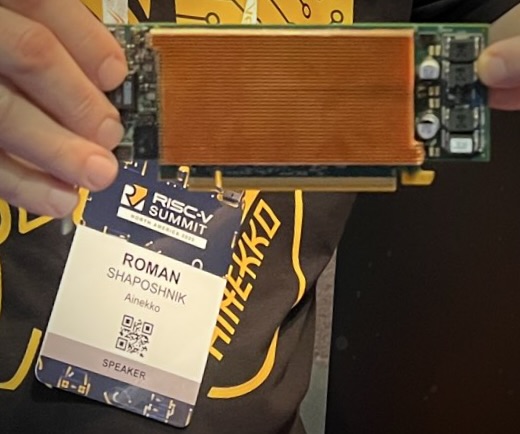Esperanto lives on at AINekko
Esperanto Technologies was founded back in 2014, completed the RTL for their Maxion CPUs in September 2018, were doing bring-up and characterization of their ET-SoC-1 in H2 2021, and were happily outlining their next-gen ET-SoC-2x and ET-SoC-3x in November 2024. Unfortunately, things did not go to plan: they closed down in July 2025, retaining just a few people to facilitate selling or licensing their accumulated IP. The official line from the company is that competitors poached their staff with compensation packages up to 4x higher than what Esperanto could offer, and that slowly bleeding staff led to eventual death. Some voices in the media instead posit that the company failed on publicity and community engagement. Amongst other potential problems, their website (still) has an "I want to evaluate Esperanto systems" form, rather than an online store with prices and "Add to cart" / "Go to checkout" buttons. Being an AI chip startup is hard: you've got to get lots of things right, and just one of them being wrong is enough to condemn you to failure.
Fast-forward to the present day - October 2025 - and AINekko drops out of stealth, with two interesting repos on GitHub: et-platform and et-man. I don't know for sure, but it looks like AINekko purchased the ET-SoC-1 IP, and is proceeding to open it all up. et-platform contains a simulator, a kernel driver, and all sorts of firmware / bootcode / management software, all available under the Apache License v2. Meanwhile, et-man currently contains "just" a comprehensive programmer's reference manual, but it looks like more documentation should land there in due course. There's also a claim that the RTL will be open-sourced eventually, though I imagine that this will only be the RTL written by Esperanto, and not any 3rd-party IP they licensed to include in their chip (e.g. PCIe controllers from Synopsys). The et-platform README helpfully states:
AINekko's ET is an open-source manycore platform for parallel computing acceleration. It is built on the legacy of Esperanto Technologies ET-SoC-1 chip.
It lives on, but what exactly is this chip? There's a photo of AINekko's CTO holding one of the PCIe boards on X:

An image from the Esperanto product page shows what's under that heatsink:

Presumably it's a PCIe Gen4 x8 edge connector on the bottom, 32 GiB of LPDDR4x (the four ~square black chips), and an ET-SoC-1 in the middle. The ET-SoC-1 ASIC is itself a grid of tiles with a NoC mesh stop in each tile:
There are four different types of tile:
| Kind | Count | Contents (per tile) |
|---|---|---|
| DRAM | 8 | Bridge to 4 GiB LPDDR4x (2 16-bit channels per tile) |
| PCIe | 1 | Bridge to host over PCIe |
| Maxions | 1 | 4x Maxion CPU core, 1x Minion-lite CPU core, 5 MiB SRAM |
| Minions | 34 (†) | 32x Minion CPU core (2 threads each), 4 MiB SRAM |
(†) Documentation suggests that 1 of the 34 is lost for yield purposes, leaving 33 usable.
This grid is somewhat reminiscent of a Tenstorrent Wormhole or Blackhole, though with a major philosophical difference: the Tenstorrent approach is to have a separate address space per tile with software explicitly initiating asynchronous NoC transactions to move data around, whereas ET-SoC-1 adopts a more GPU-like approach with a single address space spanning the entire ASIC and a hierarchy of hardware L1 / L2 / L3 caches to mitigate latency. Another big difference at the NoC level is that Wormhole and Blackhole choose to go with two unidirectional toruses, whereas ET-SoC-1 has a single bidirectional grid.
The DRAM and PCIe tiles are relatively mundane, containing LPDDR4x controllers and PCIe controllers respectively. Neither has any programmable CPU cores, and they are mostly transparent to software: parts of the address space do physically live in these tiles, but software doesn't need to worry about the physical location of memory, as the NoC hides the details.
Next up, the Maxions tile is roughly similar to a Tenstorrent ARC tile combined with a SiFive x280 tile as found on Blackhole: each Maxion CPU core is a 64-bit RISC-V single-threaded superscalar out-of-order CPU core capable of running Linux, just like a SiFive x280, and the Minion-lite serves the same role as an ARC core with regards to board and system management. The 5 MiB SRAM in the tile is split as 1 MiB scratchpad for the Minion-lite and 4 MiB L2 for the Maxions (though the L2 can instead be reconfigured as scratchpad).
The majority of the ET-SoC-1 ASIC is made up of Minion tiles, similar to how the majority of a Tenstorrent ASIC is made up of Tensix tiles. Both contain low-power in-order RISCV cores, but the differences quickly become apparent. There is a lot to be said about these minions, but it'll have to wait until next time.
